Go the extra mile
Towards a cooler planet
How to set up a beehive and begin beekeeping
1 May 2023
Beekeeping is both an art and a science. To start, it is important to know about the social life and roles of bees. This includes the queen, drones, and worker bees. Also, be prepared for bee sting allergies and get a medical check-up if needed.
Getting hands-on experience is very helpful. You can learn by observing experts or joining local beekeeping clubs. When picking a spot for your bees, consider the availability of flowers, water, and the presence of pesticides in the area.
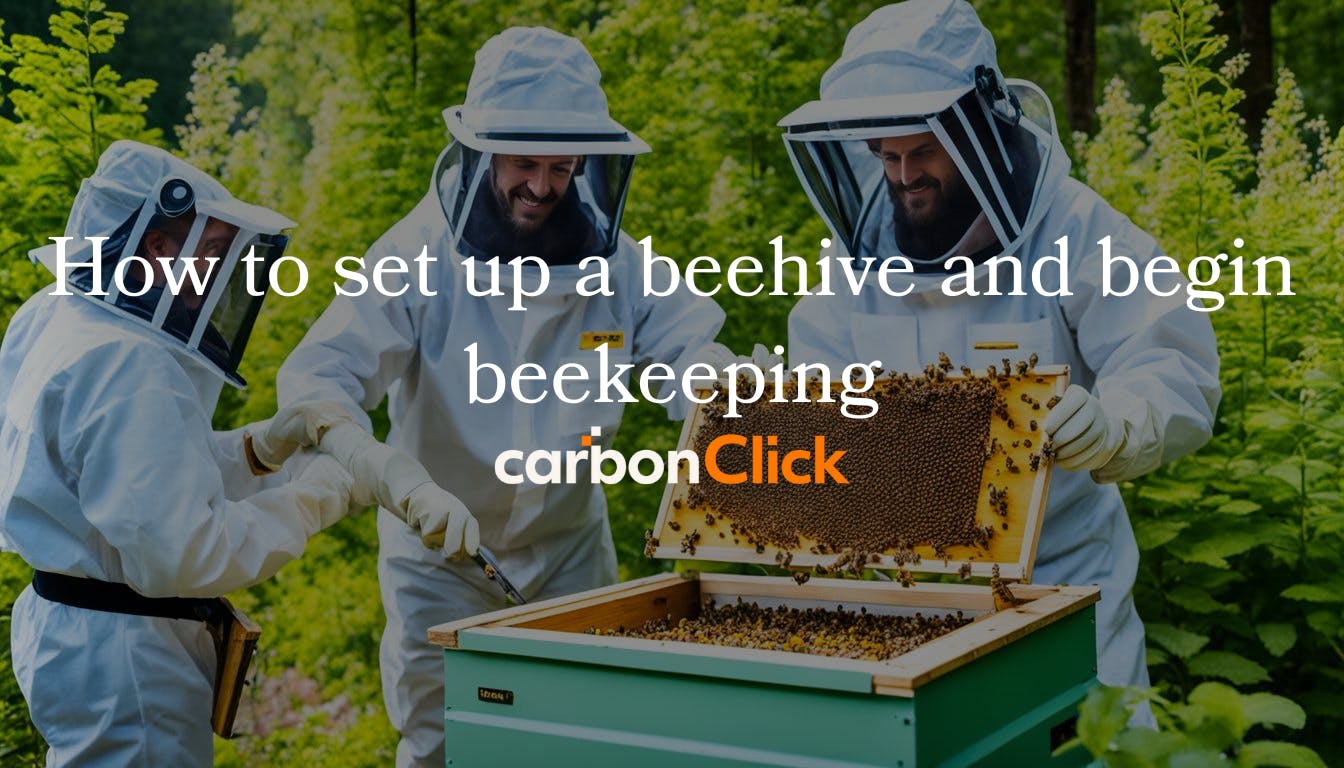
Key takeaways
Choosing the right beekeeping gear, such as hives and protective clothing, is also crucial. Setting up your beehive correctly is essential. You can choose between packaged bees or nucleus colonies (nucs), each with its own pros and cons.
After setting up, you’ll need to manage space, pests, and protect against robbers. Ensure your bees have enough food stored to sustain them.
- Understanding bee social structure is key to successful beekeeping.
- Check for potential allergies to bee stings before starting.
- Practical experience can be gained by learning from experienced beekeepers and joining clubs.
- A suitable location should have flowers, nearby water sources, and avoid pesticides.
- Choose the right equipment and set up your beehive correctly.
- Decide on packaged bees or nucs, knowing their respective benefits.
- Regular management of space, food, and pests is necessary.
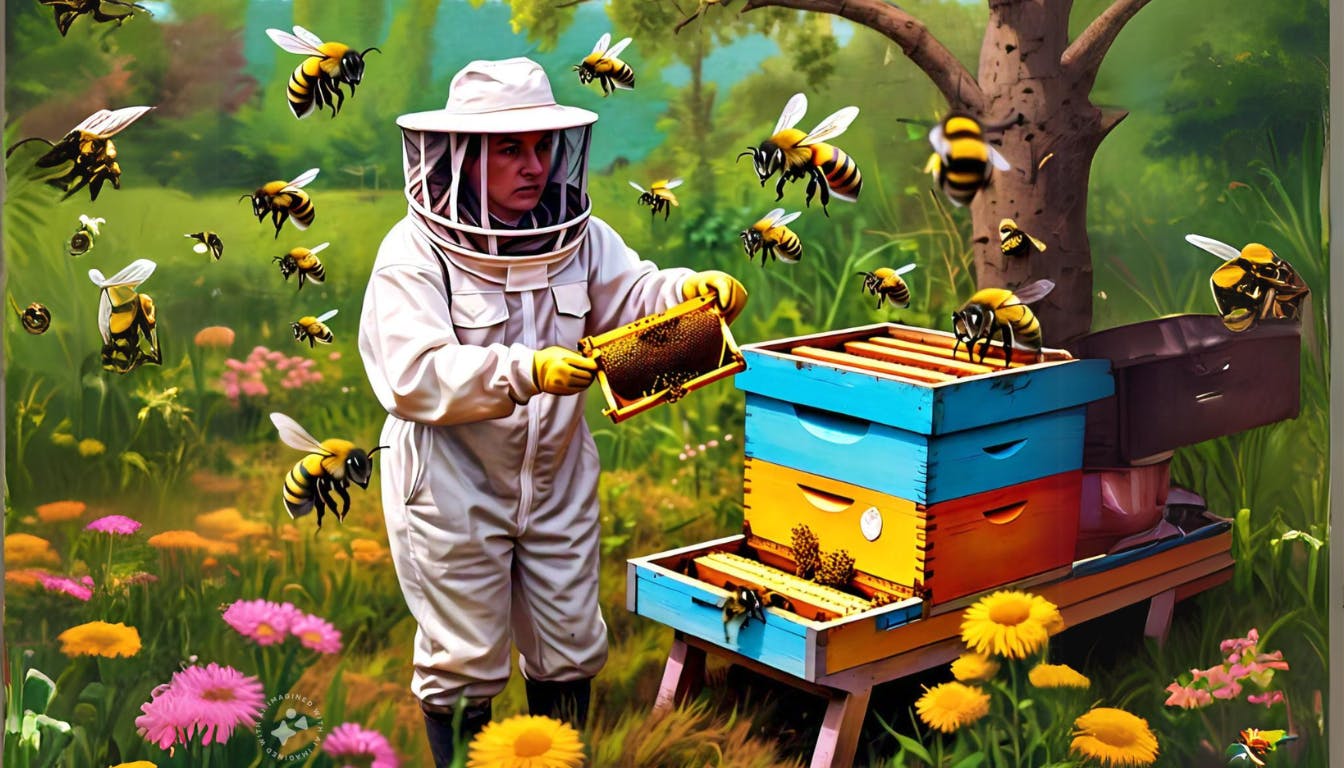
Introduction to Beekeeping
Starting your journey into beekeeping, you will encounter the significant tasks beekeepers handle. They look after hive health, assist with honey production, and ensure the bees' living conditions are optimal. It’s a role that’s both rewarding and challenging.
First, let’s examine the roles in a honeybee colony. The queen bee lays eggs, maintaining the colony’s population. Worker bees, all female, perform various tasks such as foraging and caring for the young. Drones, the male bees, are present primarily for mating.
Being a beekeeper involves considerable effort. You need to manage hive space, keep pests at bay, store food, and care for the queen. Pests like varroa mites, small hive beetles, and wax moths are common threats. To combat these, beekeepers use mouse guards, raise hives off the ground, and sometimes even install electric fences to keep out skunks and bears.
With climate change and environmental issues on the rise, sustainable beekeeping is essential. It helps bees not just survive but thrive. They pollinate 30% of the world’s food crops and support over 90% of flowering plants. Our actions can significantly benefit bee populations.
Beekeeping is suitable for people of all ages and backgrounds. It fits well in both rural and urban settings. As more people take up this hobby, remember to acquire bees early in the year. This helps your hive establish a strong start by spring.
Understanding Honeybee Biology
The world of bees is fascinating, with a clear colony structure. Each bee has a vital role for the hive's survival and growth.
Roles of the Queen, Worker, and Drone Bees
The bee life cycle depends on the queen, worker, and drone bees. The queen is at the top, laying up to 2,000 eggs a day (not 200,000 a year). She's the only one who can reproduce.
Worker bees, all female, perform crucial tasks like feeding the young, gathering nectar, and keeping the hive safe. Drones, the male bees, focus on mating with the queen.
Importance of Bee Colonies
Understanding how bee colonies function is key to successful beekeeping. Worker bees can number in the thousands, reflecting the hive's detailed organisation. The life cycle from egg to adult mirrors the hive's structure.
A queen lays fertilised eggs, which become female workers. Workers manage the young bees. Drones begin mating flights at around two weeks old, with mating as their primary role.
Managing bee colonies effectively leads to healthy hives and better bee reproduction. This knowledge helps create optimal conditions for bees and supports the health of our ecosystems. Many new beekeepers live in suburbs, making the Langstroth hive a popular choice for its space efficiency.
Checking for Allergies
Before starting with beekeeping, it's crucial to check if you're allergic to bee stings. Many beekeepers get stung often. On average, a beekeeper gets stung about 58 times a year.
Normal reactions to bee stings include a burning feeling, redness, itching, and swelling. But, some people may have severe allergic reactions. These can be very dangerous.
A person standing in front of a beehive, wearing protective clothing and holding a bee smoker. They are looking down at their arm which has a red, swollen mark from a recent bee sting. The person is using tweezers to remove the stinger while another person stands nearby with an EpiPen in case of an allergic reaction. The surrounding area is filled with blooming flowers and buzzing bees.
Severe allergic reactions can show as hives, rash, and swelling. They can also cause breathing problems, stomach cramps, and feeling very tired. In the worst cases, anaphylaxis can happen, leading to shock, trouble breathing, and even losing consciousness. So, being safe from bee stings is very important.
I found out I was allergic to honeybee venom after a few years of beekeeping. This was after removing a bee colony and getting stung several times. Luckily, allergy shots helped me get used to the venom. These shots were given weekly at first, then less often, which helped reduce allergic reactions.
These allergy shots, or immunotherapy, can cut the risk of anaphylactic shock by up to 98%. They also made me feel less anxious when working with bees. But, sometimes, I had to go back to getting shots every four weeks instead of six. This shows how important it is to keep up with health safety in beekeeping.
Only about half of beekeepers wear all the protective gear they should. It's vital to wear a suit, veil, gloves, and boots to avoid getting stung. Always talk to a doctor if you're not sure if you're allergic to bee stings.
In short, being careful and knowing about allergic reactions is crucial for safe and fun beekeeping.
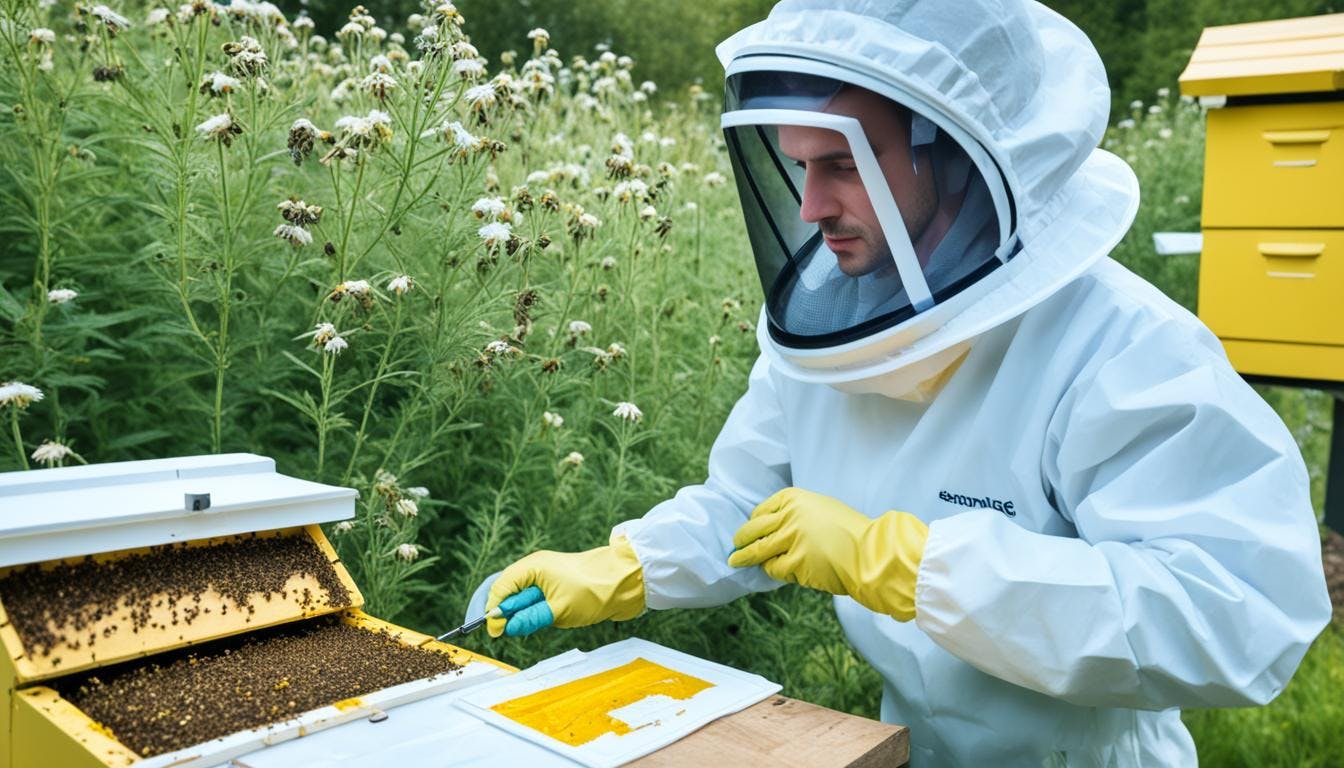
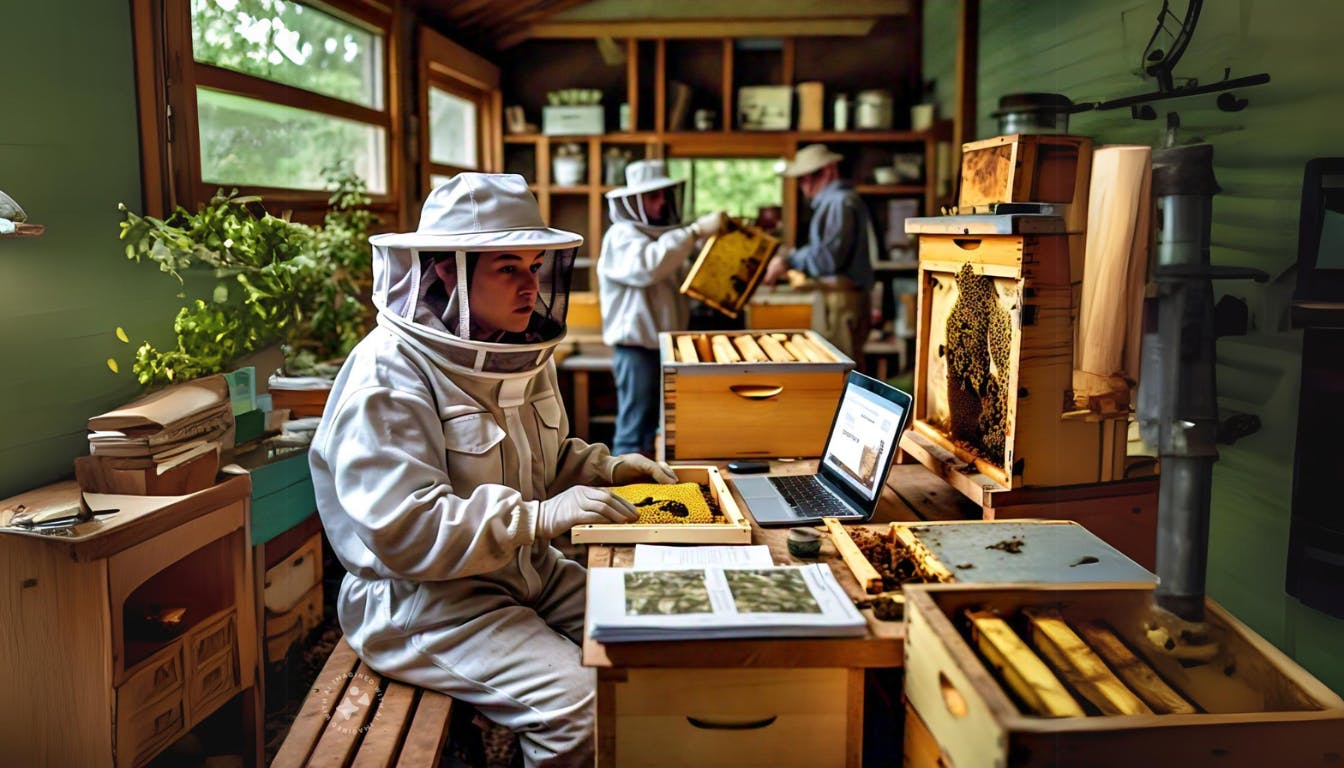
First steps in Beekeeping
It's vital to understand bee biology in beekeeping. You can learn through beekeeping education from books, documentaries, blogs, and online courses. It’s important to keep fresh water near the hive and check the hive weekly to identify problems like varroa mites early. Having a solid understanding from the start helps you take better care of your bees.
Shadowing Experienced Beekeepers
Learning from experienced beekeepers is a great way to improve. By observing them, you can see how they manage bees. Taster days, costing around £30, allow you to see what beekeepers do within a 2-3 km area from the apiary. These sessions also teach you why regular checks are crucial to keeping your bees healthy and productive.
Joining Local Beekeeping Clubs
Joining a local beekeeping club offers many benefits. These clubs provide 'start beekeeping' courses with eight evening sessions. Courses can have up to 50 participants and cost about £100 each, helping clubs generate revenue. They also encourage community apiary involvement. Mentoring new members for 1-2 seasons aids their learning and supports long-term beekeeping.
Choosing the right Beehive location
Finding the perfect spot for our beehive is key to successful beekeeping. Whether in the city or countryside, we must think about several things. This ensures the bees stay healthy and work well. Let's look at what's best for bees.
Factors to Consider
When picking a spot, sunlight, wind protection, and height matter a lot. Experts say bees do better in the sun. The USDA suggests full sun is best in zones 1 to 6. But, zones 7 to 11 need some shade to avoid too much heat.
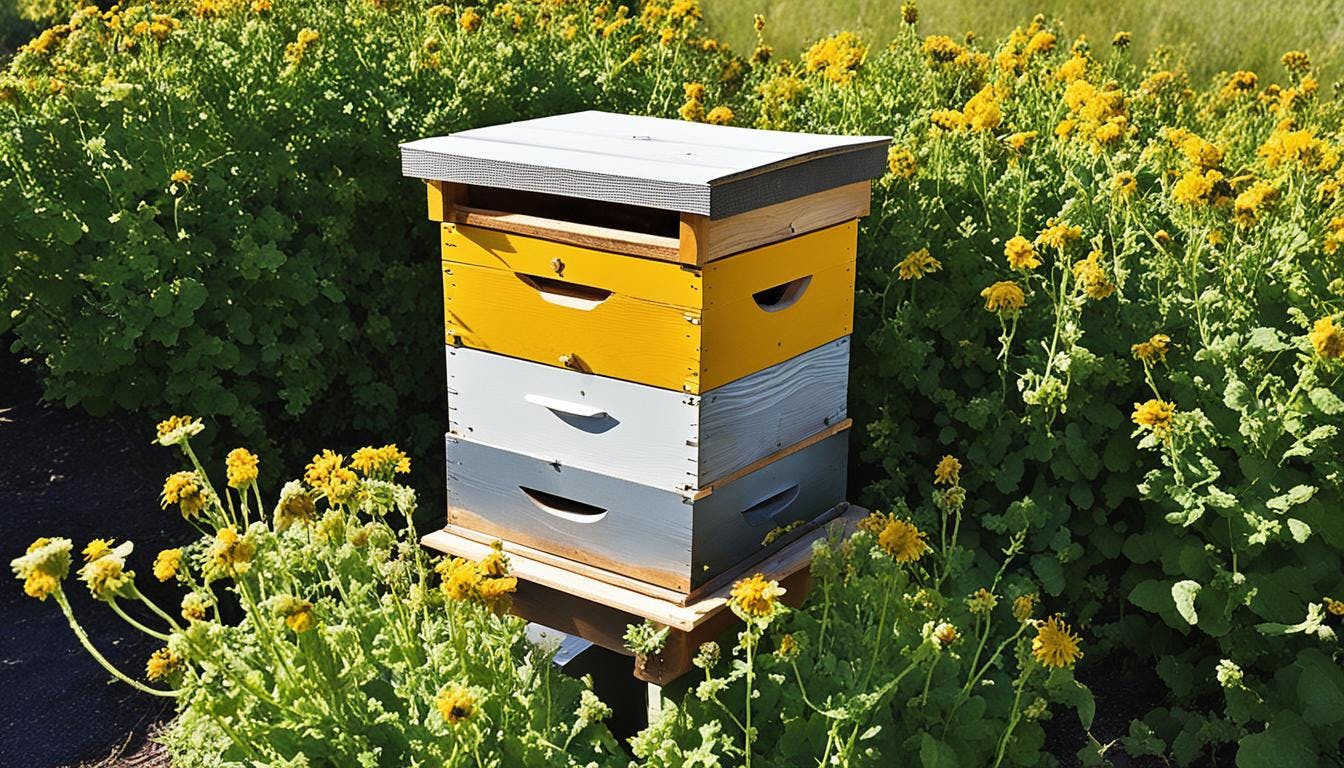
“Facing the hive entrance southeast captures the morning sunlight, which helps bees start their workday earlier and also offers protection from prevailing winds.”
Essential Bee resources
Wind barriers such as hedges or fences help protect bees from strong winds. Elevating the hive by at least 12 inches keeps it dry and protects it from pests like skunks.
Importance of Flowers and Water Sources
Bees can travel up to 5 miles for food, so proximity to flowers and water is crucial. Having nearby plants and water sources conserves bees' energy and enhances their productivity. Ponds, ditches, or even pools can serve as good water sources if they are the closest available.
Avoiding Pesticides and High Traffic Areas
It is important to keep your hives away from busy areas and pesticide use. This protects bees from threats and harmful chemicals. Your bee area should be quiet and secure for the bees.
By considering these factors and taking appropriate actions, you can create an excellent environment for your bees. This leads to a strong and successful bee colony.
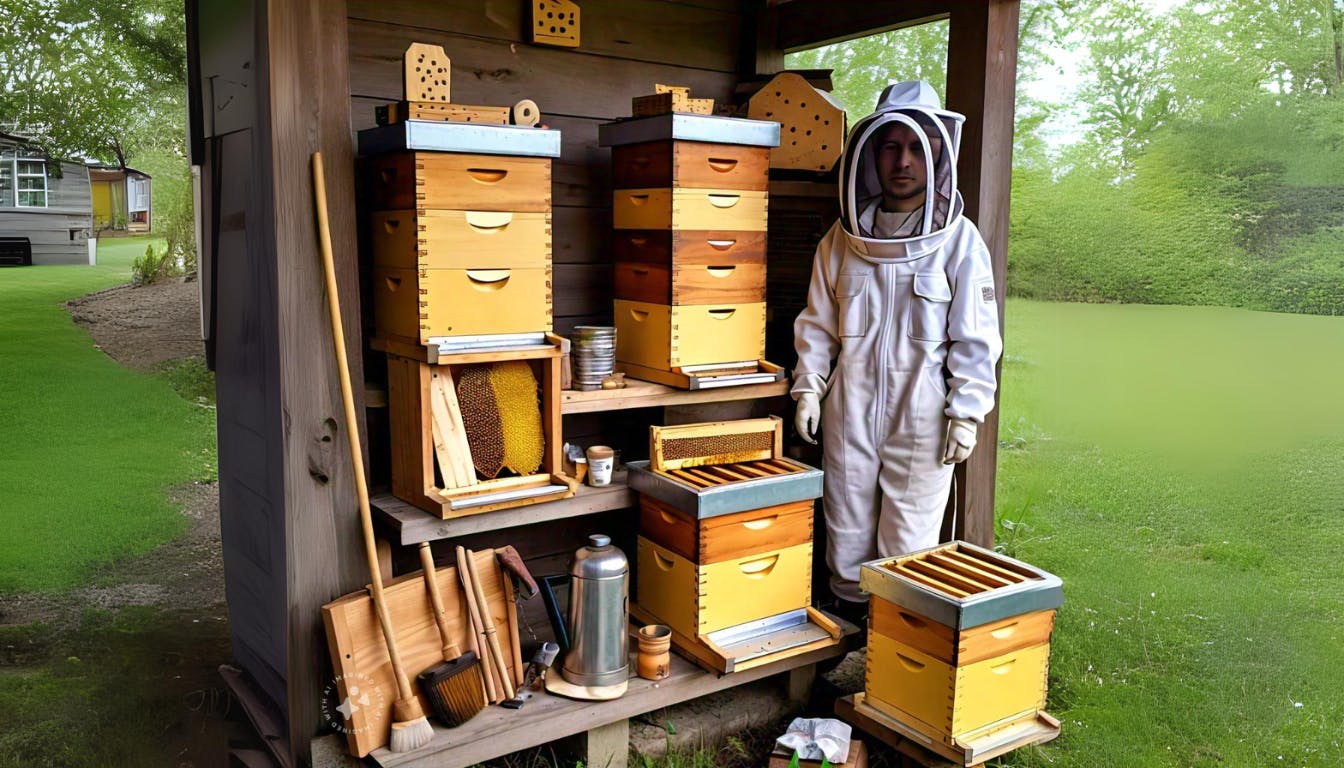
Selecting Beekeeping equipment
Choosing the right beekeeping equipment is key to a successful beekeeping journey. We must consider the type of hives and the tools needed to care for our bees. Getting the right gear saves time and keeps us and our bees safe.
Common Types of Hives
There are various types of hives, each suited to different beekeeping styles. Langstroth hives are popular in many countries, including the U.S., for their design and ease of use. They consist of stacks of boxes with removable frames, making it simpler to inspect the bees and harvest honey.
Choosing a hive style can also help with obtaining advice and resources from others in the area.
Essential Tools and Gear
Some tools are essential for beekeeping. Protective clothing is crucial, especially for beginners. A full beekeeping suit with a hood offers protection from stings.
Experienced beekeepers may use less gear but still find a veil useful for protection against stings. Hive tools, such as a hand-forged one from Portland, Oregon, are vital for opening hive bodies and removing propolis. A good smoker, preferably made from stainless steel with a heat shield, calms the bees during inspections.
Feeding the bees is important. Various feeders, like tanks or those placed at the hive entrance, can be used. Being resourceful, such as using a chick waterer for syrup, can be effective. A bee brush is also necessary for carefully removing bees from frames during honey harvest.
Being organised is crucial, and a well-stocked toolbox is helpful. A toolbox made from scrap wood is a cost-effective option. Keeping tools like the bee brush and hive tools in order simplifies beekeeping.
Learning and adapting are key in beekeeping. Having a collection of beekeeping books helps keep us updated on best practices and colony management. With the right gear and knowledge, beekeeping can be very rewarding.
Step-by-Step guide to setting up a Beehive and starting Beekeeping
etting up a beehive is an exciting venture that can be incredibly rewarding. For beginners, it's essential to understand the basics of setting up an apiary and establishing a bee colony. Let’s guide you through the steps for a smooth start.
The history of modern beehive design dates back to 1852. Lorenzo Lorraine Langstroth patented the moveable-frame honey beehive. This innovation revolutionised beekeeping, making it easier to manage hives and extract honey. Today, companies like Dadant use materials such as Ponderosa Pine from the Northwestern U.S. for their beehives, ensuring durability.
A typical beehive has several parts:
- Hive stand
- Bottom board
- Hive body
- Queen excluder
- Honey super
- Inner cover
- Hive cover
Each part is crucial for the bees' well-being and honey production. The hive body can accommodate between 50,000 and 60,000 worker bees. In colder areas, adding another hive body provides additional space and helps the bees manage during winter.
Our beekeeping journey began in 2014 with a one-day Beginner’s Beekeeping class. Since then, we've joined local beekeeping clubs and used online resources like YouTube and Facebook groups to learn and grow.
Essential Beekeeping Gear
Medium-sized 6-5/8″ deep supers are often used as brood boxes because they can be swapped out easily. The queen excluder keeps the queen in the hive body, helping the colony establish well. Honey supers placed above the hive body store honey and come in different depths, making them lighter and easier to handle.
Different inner covers provide the right space and ventilation for the bees. A telescoping cover protects the colony from adverse weather. It's important to place your beehive in a suitable location, away from pesticides and busy areas, but close to flowers and water. Checking the hive every two to three weeks helps monitor its health and prevent swarming.
Starting beekeeping requires the right gear. Obtaining a Flow Hive 2 package with an organic cotton bee suit and Flow Smoker is a good choice. Keeping a beekeeping journal to record your experiences and observations is also a great idea for beginners.
Preparing your Hive for Bees
Getting your hive ready for bees is a key part of beekeeping. It involves assembling the hive, preparing the foundation, and placing it in your apiary. Let's look at the important steps for each part.
Assembling the Hive
The first step in assembling the hive is gathering tools such as clamps, a carpenter’s square, and nails. You can choose from Langstroth, Warre, or Top Bar hives, with Langstroth being the most common. You’ll need to assemble boxes and frames for the hive.
It’s important to ensure the hive is stable. Use the correct number of nails for the frames to make it sturdy. Once everything is assembled, paint the outside to protect it from the weather.
Setting Up Hive Foundations
Preparing the foundation is crucial for the bees to build wax. You can use plastic, foundationless, or beeswax with wire support. Here’s what to do next:
- Insert the foundation into each frame securely.
- For beeswax foundations, add wire support for extra stability.
- With foundationless options, ensure the edges are smooth to protect the bees.
Placing the Hive in Your Apiary
Choosing the right spot for your hive is crucial in the apiary setup. It should be near gardens, fields of flowers, or orchards for the bees. The hive should ideally face south or southeast and have a clear area in front of the entrance.
It’s also important to keep the hive off the ground. Use a stand to prevent water from collecting underneath. To stop the hive from being blown over, place obstacles behind it. Ensure the hive is easy to reach for maintenance but not in a busy area.
By following these steps, you’ll ensure your beehive is ready for the bees. This will help them thrive in their new home.

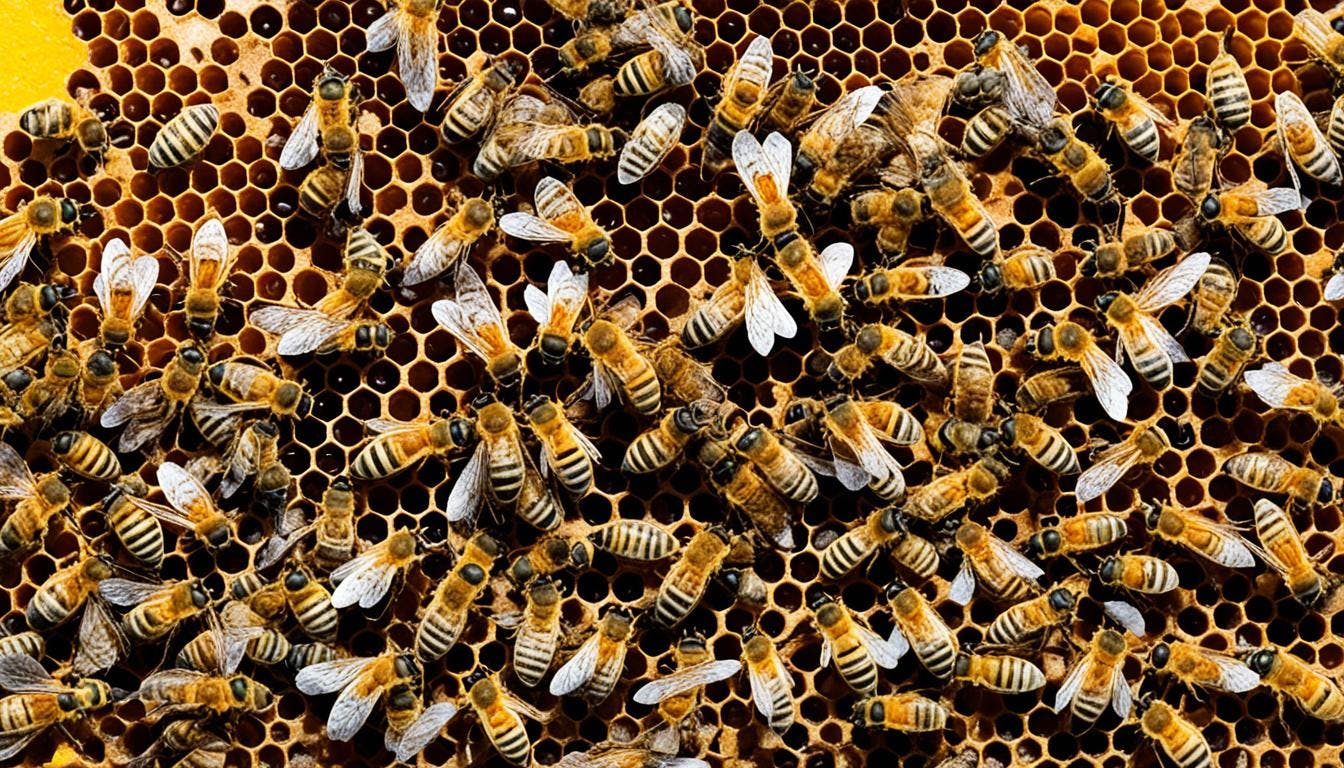
Introduction to packaged Bees and Nucs
Starting your beekeeping journey involves exploring your options. It’s important to understand the differences between packaged bees and nucleus colonies (nucs). This knowledge helps you make the right choice.
Differences Between Packaged Bees and Nucs
Packaged bees typically come in sizes of 3 pounds or 5 pounds, containing around 10,000 to 15,000 worker bees along with a queen. Nucleus colonies (nucs), on the other hand, are smaller colonies taken from larger ones. They consist of 5 frames with brood, workers, a queen, and some honey. The choice depends on your needs and beekeeping goals.
Pros and Cons of Each
When comparing nucleus colonies to packaged bees, there are several points to consider:
- Packaged Bees:
- Lower cost (generally less expensive than a nuc, usually between £80 and £160).Available earlier in the season (typically from April to June).Requires comb building, thus needing more equipment.Delayed productivity timeline as the colony needs to build up from scratch.
- Nucleus Colonies (Nucs):
- Includes established comb, brood, and honey.Faster colony establishment and immediate productivity.Higher queen success rate due to the presence of an established queen.Higher initial cost (around £240 to £300).
You should consider the advantages of nucleus colonies versus packaged bees for your specific situation. Understanding these bee colony types helps you choose the best option for your apiary.
Installing packaged Bees
Starting a bee colony involves installing your packaged bees correctly. Check the package for any dead bees and keep it in a cool, dry spot. A few dead bees are normal, but an excessive number could indicate shipping issues. The package typically contains about 10,000 live bees, a feeding can, and a cage with the queen and a few workers.
Step-by-Step Installation Guide
Prepare your gear: hive tool, pliers, toothpick, smoker, misting bottle with sugar syrup, protective clothing, feeder, entrance reducer, and possibly a camera. Install the bees in the late afternoon or early evening when they are calmer. Mist them with sugar syrup to calm and feed them.
Open the package and let the bees out slowly, or gently shake them into the hive. Ensure the queen is placed safely between two frames with a candy plug or a mini marshmallow if needed. This helps the workers get accustomed to her scent over a few days. Keep the hive warm (above 18°C) to protect the bees.
Immediate Post-Installation Care
After installing the bees, provide them with plenty of sugar syrup to help build wax comb and feed them. Monitor the hive for issues such as workers not accepting the queen, insufficient wax comb production, or the queen laying only drone brood. Check the hive five days after installation to ensure the queen is doing well. Check again after another five days to confirm she is laying eggs.
If the workers do not accept the queen, you may need to replace her or combine the colony with another. By following these steps, you can establish a strong, healthy bee colony.

FAQ's
How do we set up a beehive and start beekeeping?
To set up a beehive, choose an appropriate spot and assemble the hive. Ensure there is water and flowers nearby but keep the hive away from pesticides.
What do we need to know about apiculture before starting?
Learn about the social structure of bees, including the queen, workers, and drones. Beekeepers must manage hive health, honey production, and the surrounding environment. Consideration of climate change is also important.
What roles do the queen, worker, and drone bees play in the hive?
The queen lays eggs. Worker bees feed the young and gather nectar. Drones mate with the queen. Each type of bee is essential for the hive's success.
Why are bee colonies important?
Bee colonies are crucial for pollination, which aids in food production and maintains biodiversity. Understanding colonies helps beekeepers keep bees healthy and ensure sustainability.
How do we check for allergies to bee stings?
Determine if you are allergic by consulting a doctor for a test. This helps prevent severe reactions such as throat tightness or rapid heartbeat, which can be life-threatening.
What are the first steps in learning about beekeeping?
Begin with books, documentaries, and online courses on bee biology. Observing experienced beekeepers and joining local beekeeping clubs provides practical learning and support.
How can we benefit from joining local beekeeping clubs?
Clubs offer opportunities to meet others, gain advice, and share knowledge. They make beekeeping easier and more enjoyable.
What factors should we consider when choosing a hive location?
Consider the availability of flowers and water, and avoid placing the hive in busy areas or near pesticides. Also, be aware of legal requirements and think about honey harvesting.
What are the common types of hives and essential tools for beekeeping?
Langstroth hives are popular, especially in the U.S. Essential tools include protective gear, hive tools, and feeders. Choosing a common hive type helps with access to resources and advice.
How do we assemble and prepare our hive for bees?
Assemble the hive parts, set up the foundation, and place it correctly. Prepare by making frames, adding foundation, and painting the outside to protect it from the elements.
What are the differences between packaged bees and nucleus colonies (nucs)?
Packaged bees come with a queen and workers, sometimes with or without comb. Nucleus colonies include frames with brood and honey. Choose based on your beekeeping needs.
How do we install packaged bees into the hive?
Check the package for a few dead bees, keep it cool and dry, and let the bees exit slowly or gently shake them into the hive. After installation, provide food and help them settle in.
17 South Street
Auckland 1010
New Zealand
info@carbonclick.com- -
- X
Sign up. Be inspired. Get clicking.
Subscribe now to stay up to date with CarbonClick, carbon offsetting and climate action.
By signing up you agree to our Privacy Policy.


